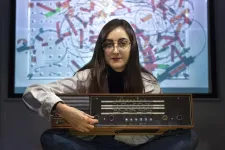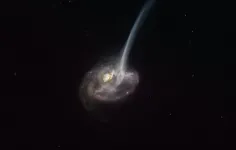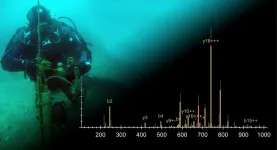(Press-News.org) Would you like to capture a chemical transformation inside a cell live? Or maybe revolutionize microchips' production by printing paths in a layer that has a thickness of just 100 nanometers? These and many other goals can now be achieved with the latest femtosecond laser created by a team of scientists led by Dr. Yuriy Stepanenko.
These days, there is a multitude of laser light sources. They each have their characteristics and different applications, such as observing stars, treating illnesses, and surface micro-machining. "Our goal is to develop new ones," says Yuriy Stepanenko, head of the team of Ultrafast Laser Techniques at the Institute of Physical Chemistry of the Polish Academy of Sciences. "We deal with sources that produce ultrashort pulses of light. Really very, very short - femtosecond pulses (that's a part of a second with 15 zeros after the decimal point). This is the scale on which, for example, intracellular chemical reactions take place. To see them, we have to "take a photo" in this very short time. And thanks to the new laser, we can do just that.
"We can also use our source for the very precise removal of materials from various surfaces without destroying them," says the scientist. "We could, for example, clean the Mona Lisa using this method without damaging the layers of paint. We would only remove dust and dirt, a layer about 10 nanometers thick," explains Dr. Stepanenko, one of the authors of a study recently published in the Journal of Lightwave Technology.
"But for this sort of job, our laser is even rather too precise," notes Dr. Bernard Piechal, co-author of the publication. "For this, you only need nanosecond pulses, i.e. pulses lasting a thousand times longer. The latter, however, would not be able to, for instance, draw paths of precisely planned depths in ultra-thin materials, e.g. removing gold sprayed on microchips with a precise adjustment of the thickness of the layer being removed. But our laser can do this! It can also make holes in tempered glass or ultra-thin silicon plates. In these conditions, a nanosecond laser would either melt the silicon or "smash" the glass because it produces too much heat. Too much energy is concentrated locally in a very small area. Ours works firmly but gently," grins Dr. Stepanenko.
How was this effect achieved?
"We wanted our source to meet two conditions: it was to be susceptible to mechanical disturbance to the least possible extent, and it was to be mobile," explains Dr. Piechal. "We did not want to create a huge, stationary structure."
Fibre-optic lasers came to the rescue of the team. "This sort of laser is basically an optical fibre enclosed in a ring. The laser pulse runs inside it without being exposed to mechanical disturbances. The optical fibre can be touched, moved, even shaken without compromising the stability of the pulse. Of course, if the light only ran round in a circle like this, it would be useless, so part of this impulse is directed outside the loop in one place in the form of useful flashes," explains Dr. Stepanenko, with a smile.
Here we come to another important parameter of this sort of pulsed laser: the frequency with which the pulses appear at the output. In conventional designs, this frequency depends on the length of the fibre optic loop in which the pulse travels. Its practical length is several dozen metres. Which is quite a lot, isn't it? What if we wanted flashes of light to appear as often as possible? This can be done by reducing the circumference of the ring through which the pulse travels. Only that this sort of action has its limits. "In our lasers, the smallest loop gives pulses every 60 nanoseconds, which is still too slow for our desires," explains the researcher. How can this frequency be accelerated? This is where the new invention of the team from the IPC PAS comes in: a system that allows the basic frequency to be duplicated as if creating harmonic frequencies on the basic frequency of a guitar string. "We use so-called Harmonic Mode Locking," explains Dr. Stepanenko. "What is innovative in our design is that we are able to switch this repetition rate in a controlled way and select only one of the possible harmonics, the particular one we need. You could say that we are like a guitarist- on an open string, i.e. our loop of the fibre, we obtain a specific frequency resulting from its length. When we put our finger exactly in the middle of the string, we get the so-called second harmonic. The pitch increases by an octave and the vibration frequency doubles. If we put our finger on 1/3 of the length of the string, we get a frequency equal to three times higher than on the open string. In our case, we increase the frequency of the pulses by turning the knob. We can only do it in steps, each time getting another harmonic, just as the harmonics in the guitar change in steps, but the range is quite large: we can change our light harmonics from 2 up to 19 times above the basic frequency, i.e. reach a frequency of pulses up to just over 300 MHz.
It is extremely important that the obtained frequencies are stable and can be precisely distinguished. If we choose a harmonic, all the others will be so damped that their "volume" will be about 10 million times lower than that of the chosen one. You could say that we are generating a pure sound and eliminating all the background noise. In addition, the higher the frequency, the better it is defined. "We are the first to have managed to do this so well," says the researcher proudly.
It is left to us to wait for the invention to be implemented in more industrial applications. Perhaps it will mean even thinner and lighter laptops for us or better knowledge of what is happening inside the human body.
INFORMATION:
This project was carried out thanks to the NCN grant UMO-2017/25 / B / ST7 / 01145
B. Piechal, J. Szczepanek, T. M. Kardas and Y. Stepanenko, "Mamyshev Oscillator with a Widely Tunable Repetition Rate," in Journal of Lightwave Technology,
doi: 10.1109/JLT.2020.3031540.
The study found a "systematic and quantifiable pattern" of political parties officers opting against fielding minority candidates where they perceive that their non-white appearance might prevent a win. This includes constituencies already held by the party, and those within reach, requiring just a small swing in the vote to change hands.
Dr Patrick English, from the University of Exeter, who carried out the research, said: "This combination of public opinion and party strategy is one of the most significant blockages to electing parliaments which fully reflect ...
A team of researchers from Colorado State University and the University of Cincinnati have discovered a new mode of snake locomotion that allows the brown tree snake to ascend much larger smooth cylinders than any previously known behavior.
This lasso locomotion, named because of a lasso-like body posture, may contribute to the success and impact of this highly invasive species. It allows these animals to access potential prey that might otherwise be unobtainable and may also explain how this species could climb power poles, leading to electrical outages.
Researchers said they hope the findings will help people protect endangered birds from the snakes.
The ...
Researchers reporting in Current Biology on January 11 have discovered that invasive brown tree snakes living on Guam can get around in a way that had never been seen before. The discovery of the snake's lasso-like locomotion for climbing their way up smooth vertical cylinders has important implications, both for understanding the snakes and for conservation practices aimed at protecting birds from them.
"Our most important finding is a new mode of snake locomotion," says co-senior author Julie Savidge of Colorado State University (CSU). "Only four major types have been recognized for nearly 100 ...
What The Study Did: Researchers examined pediatric COVID-19 hospitalization trends in 22 states for both severity among this population and spread of the virus.
Authors: Pinar Karaca-Mandic, Ph.D., of the University of Minnesota Carlson School of Management in Minneapolis, is the corresponding author.
To access the embargoed study: Visit our For The Media website at this link https://media.jamanetwork.com/
(doi:10.1001/jamapediatrics.2020.5535)
Editor's Note: The article includes conflict of interest and funding/support disclosures. Please see the article for additional information, including ...
What The Study Did: Medical records for patients admitted to an urban academic medical center were analyzed for race and ethnicity for evidence of racial bias in clinician documentation.
Authors: Jessica R. Balderston, M.D., of Virginia Commonwealth University Medical Center in Richmond, is the corresponding author.
To access the embargoed study: Visit our For The Media website at this link https://media.jamanetwork.com/
(doi:10.1001/jamainternmed.2020.5792)
Editor's Note: The article includes conflicts of interest disclosures. Please see the article for additional information, including other authors, author contributions and affiliations, conflict of interest ...
BOSTON - A diet rich in healthy and plant-based foods is linked with the presence and abundance of certain gut microbes that are also associated with a lower risk of developing conditions such as obesity, type 2 diabetes and cardiovascular disease, according to recent results from a large-scale international study that was co-senior authored by Andrew T. Chan, MD, MPH, from Massachusetts General Hospital (MGH). The report appears in Nature Medicine.
"This study demonstrates a clear association between specific microbial species in the gut, certain foods, and risk of some common ...
Smartwatches and other battery-powered electronics would be even smarter if they could run AI algorithms. But efforts to build AI-capable chips for mobile devices have so far hit a wall - the so-called "memory wall" that separates data processing and memory chips that must work together to meet the massive and continually growing computational demands imposed by AI.
"Transactions between processors and memory can consume 95 percent of the energy needed to do machine learning and AI, and that severely limits battery life," said computer scientist Subhasish Mitra, senior author of a new study published in Nature Electronics.
Now, a team that includes Stanford computer scientist ...
Fish populations tend to do better in places where rigorous fisheries management practices are used, and the more measures employed, the better for fish populations and food production, according to a new paper published Jan. 11 in Nature Sustainability.
The study, led by Michael Melnychuk of the University of Washington's School of Aquatic and Fishery Sciences, draws upon the expertise of more than two dozen researchers from 17 regions around the world. The research team analyzed the management practices of nearly 300 fish populations to tease out patterns that lead to healthier fisheries across different locations. Their findings confirmed, through extensive data analysis, what many researchers ...
Galaxies begin to "die" when they stop forming stars, but until now astronomers had never clearly glimpsed the start of this process in a far-away galaxy. Using the Atacama Large Millimeter/submillimeter Array (ALMA), in which the European Southern Observatory (ESO) is a partner, astronomers have seen a galaxy ejecting nearly half of its star-forming gas. This ejection is happening at a startling rate, equivalent to 10 000 Suns-worth of gas a year -- the galaxy is rapidly losing its fuel to make new stars. The team believes that this spectacular event was triggered by a collision with another ...
Most organisms on earth depend on the energy from the sun. Sunlight is also an important coordinator of life's timers. Animals take important cues for proliferation, activity, feeding, or sleep from changing light conditions. These rhythms also exist in humans - as changing light conditions across the year can strongly impact human mood and psychology.
Part of the natural light from the sun we are exposed to consists of ultraviolet (UVA and UVB) light, a short-wavelength part of the spectrum that is largely missing in artificial lighting. So far, most research on seasonal cycles has focused on daylength. "In contrast to previous assumptions, we discovered that, in addition to daylength, the intensity of UVA light influences the seasonal responses of the bristle worm ...




